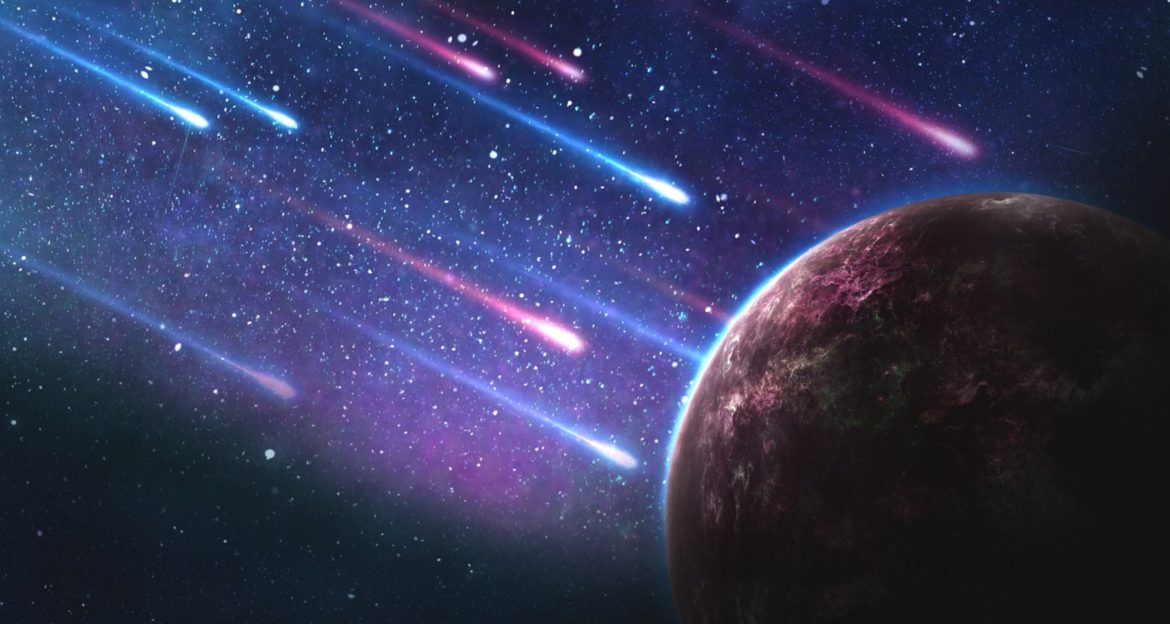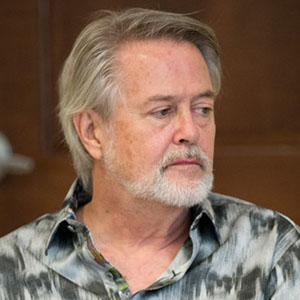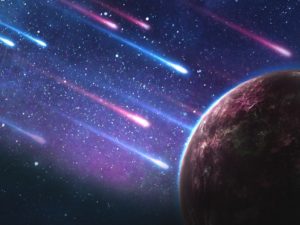
Borne by Jeff VanderMeer (Fourth Estate)
The dark, dangerous, funny and uplifting new novel from the author of Annihilation, the inspiration for the major motion picture directed by Alex Garland.
‘Neither of us had control of our monsters anymore’
In a ruined city of the future, Rachel scavenges a strange creature from the fur of a despotic bear.
She names him Borne.
He reminds her of her homeland lost to rising seas, but her lover Wick is intent on rendering him down as raw material for the special drugs he sells. Nothing is quite what it seems, and if Wick is hiding secrets, so too is Rachel – and Borne most of all.
It has been short-listed for the 2018 Arthur C. Clarke award. A selection of our panel of shadow jurors respond to the novel below…
Gary K. Wolfe

Borne is the only novel on the list that I had a chance to review last year, and here’s part of what I said then:
With Borne, VanderMeer may have produced his most focused and linear novel to date, using out-of-control biotech as his engine, but what we notice first, and remember afterward, are the vengeful Godzilla-sized flying bear named Mord, the glutinous, evolving blob named Borne, and the tragic but determined narrator Rachel. . . .
Rachel carries with her a few scraps of memory of a better life as a child, but now spends much of her time holed up with a rather secretive scientist named Wick, who works as a kind of drug dealer mainlining altered beetles that can add or erase memories. They survive in a partly collapsed redoubt called the Balcony Cliffs, from which Rachel ventures out to scavenge. On one such expedition, she finds a fist-sized purple-and-green blob entangled in the fur of Mord, the giant flying bear who rules the ruined city. Mord is both the Company’s greatest achievement and its worst nightmare. The blob is Borne, a living creature who consumes voraciously but never seems to excrete anything, so that it grows rapidly, develops a touchingly childlike intelligence, and for a while acts as Rachel’s trusting ward. The triangle of affection between Rachel, Borne, and Wick is soon tested not only by Wick’s suspicions, but by Borne’s shape-changing abilities, and by the threats to their safety represented not only by the bear Mord (and his army of bear minions), but by Wick’s crosstown rival known only as the Magician.
VanderMeer wisely doesn’t offer many details about how the Company gained such power or how the biotech apocalypse actually unfolded, though he offers a wealth of poetically named examples, of which my favorite are the “alcohol minnows”. This is actually where the novel gains its greatest strength, and displays its greatest discipline. As we learn more about Rachel, Wick, Borne, Mord, and the Magician, VanderMeer begins to unfold an intriguing backstory, and after Rachel and Wick are driven out of their safe haven, there is a fair amount of suspenseful pursuit-and-discovery action. Late in the novel, he even offers us an epic monster battle worthy of the Toho Studios. But Vandermeer never loses focus on the central question, raised initially by Borne and then addressed in different ways by Wick, Rachel, and the Magician (who does eventually get onstage) of what it means to be a “person”. Borne at one point wants to know if he really is a person, or a weapon, or if a person can be a weapon, and those anxieties underlie not only the SF rationale of the novel, such as it is, but more importantly the issues of identity that haunt every major figure in the book, including that giant bear. It’s easy to think back on VanderMeer’s fiction and remember those baroquely inventive settings from Veniss to Ambergris to Area X, but I don’t think he’s created characters quite as memorable or quite as heartbreaking as Rachel and Borne.
Looking back on the novel from a year’s perspective (I haven’t reread it), I think I’d stick with my claim that this is fundamentally a character-driven novel exploring, on several levels, what it means to be a person (if not quite what it means to be human, which seems an important distinction). This despite the wildly surreal and inventive imagery (which is almost unavoidably the first thing you notice about the novel) and the rather underdeveloped corporate biotech rational for all that imagery. VanderMeer isn’t really out to warn us about the dangers of unregulated biotech, and I doubt that those who are seriously concerned about it would put hotel-sized flying bears near the top of their list of worries. Instead, he uses biotech as a convenient agent of transformation, somewhat like Ian McDonald did with an alien meteor in Chaga or like M. John Harrison with his Kefahuchi tract in his Light series, or like any number of VR novels in which just about anything can happen. One other reviewer, I noticed, called this fascination with metamorphosis as Ovidian, and while I think that’s something of a stretch, there’s a point to be made that VanderMeer is more interested in the mythical aspects of transformation than in its particular mechanisms.
In terms of considering Borne for the Clarke Award, this raises some interesting questions. What there is of traditional SF in the novel is a means to an end, essentially a literary device rather than an effort at conceptual breakthroughs. And, to quote Seinfeld, not that there’s anything wrong with that. Just about all the novels on the shortlist do that to one degree or another, even if it’s not the way Clarke himself approached SF (and whoever said the Clarke Award was to celebrate Clarkean SF, anyway?). At the same time, Borne is less overtly speculative than the other novels on the list, and perhaps the one which most directly views SF as the scaffolding rather than the building. This approach earned him mainstream attention (reviews in The New Yorker, etc.) that differed in both degree and kind from the way SF is usually treated, and it’s my view that such attention was well-earned by the novel. It’s a viable candidate.
Nick Hubble

Perhaps because VanderMeer has not won the Clarke or even been shortlisted in the past, he has defied the recent trend for the more established authors in the field not to be shortlisted. Yes, Tricia Sullivan was shortlisted last year and Christopher Priest a few years ago for The Adjacent, but generally it is noticeable that former regulars on the list such as Kim Stanley Robinson are not featuring. This year, for example, there are three first novels on the list and VanderMeer is the senior figure in terms of output by some distance. He is also a playful, literary and relatively experimental writer but others that fall into this category, such as Adam Roberts, no longer seem to be in fashion with the judges. It is good to see someone bucking the trend and not just because VandeerMeer is owed for the bizarre failure to shortlist any of the Southern Reach volumes (no doubt the publishing format worked against their inclusion on the Clarke shortlist but it is difficult to see why Annihilation wasn’t shortlisted at least unless the term ‘science fiction’ is once more being wielded in an exclusory, gate-keeping manner). Borne absolutely deserves its place on this year’s shortlist; it’s a fantastic novel in all senses of the term.
It’s probably to its advantage that it can be read as a fairly straightforward story and has the (all too) familiar trappings of the postapocalyptic. However, it is not yet another nihilistic dystopia but a more subtle work as much concerned with alternate reality and the Dickian question of what is a person than the survival of its characters (although obviously VanderMeer cares very much about them and so do we). If the classic novels that came to my mind were Dick’s Do Androids Dream of Electric Sheep? (via Bladerunner) and the Strugatsky’s Roadside Picnic (via Stalker), the original contribution being made is through the interaction between first-person narrator Rachel and Borne himself. What is Borne? An endearing child but also an object of subtle horror. The horror lies in exactly his struggle with being a person. It’s a horror we all need to go through as the novel makes clear by the end. It might be argued that Vandermeer is a tad didactic on this point but then again if we can’t be didactic on such matters there really is no hope for humanity.
The irony, which VanderMeer fictionalises so well in this novel, is that this hope for humanity lies precisely in not being human-centric. In this respect, Borne continues the Southern Reach trilogy’s concern with transforming the universe around us to bring life and environment into a new configuration. Its closing vision of a hierarchy-free, part-wilded and part-farmed city, peopled by human and non-human persons is of a heterotopia fit for the twenty-first century.
Alasdair Stuart

Rachel lives in the last City with Wick. Wick is a slowly dying geneticist whose work and art are expressed in the creatures that keep him alive and both of them drunk. They scavenge for supplies in the remains of the City, dodging other scavengers and walking in the shadow of Mord. Mord is a vast, terrifying bear that the Company built and failed to control. Mord is the king of the city and Rachel uses his vast presence as a shield to scavenge in relative peace. Until, one day, she sees something matted in his fur…
Borne is a puzzle box of a novel that unfolds in a deceptively speedy way. Much of the first act is concerned with establishing the tattered remnants of the status quo in the city and the complex relationship Rachel has with everyone around her. We get the sense of this being a few chapters after the end of another book. The echoes of old stories still reverberate around the City, the only thing louder than Mord’s roar.
Those other stories are what the novel ultimately becomes about. Vandermeer has a fine eye for haunting images and it’ll be a while before I can forget the Three Astronauts, the bio-hazard-suited corpses Borne is so fond of. As the second act unfolds, stories and images like that become ever more important. Borne learns, Borne is hurt, Borne kills and Borne discovers boundaries it can’t admit exist, even as Rachel and Wick find their relationship tested to the breaking point by what amounts to a surrogate child. This is simultaneously the home of the novel’s best material and some of it’s weakest for me. The hyper intelligent, dangerous child is a trope SF has often been over fond of and, before Vandermeer breaks everything about the novel, Borne plays as rather too familiar here to be as interesting as others find him. That’s doubly true of The Magician, the sketched in drug lord antagonist whose history is hinted at but never explored in anything beyond intriguing detail. Rachel and Wick don’t need to know that, so we don’t get to find out. But there are times when that absence plays as a weakness more than a feature.
Then the third act arrives and all is not so much forgiven as rendered down to its component atoms. Vandermeer walks us through a final assault on Rachel and Wick’s home, the discovery of what Borne has been up to, a full bore Kaiju fist fight that reaches sanity straining levels, an even more traumatic journey into the Company’s building and origins all around. By the end of the novel everything is if not different, then sharper focused and heading in a far different direction than you thought.
This is all massively, endlessly impressive. Technically Borne is the most impressive book on this list, I’d argue, by some way. But, for me, where it falls down is in emotional engagement. The characters and text are numb with shock and that mildly flat presentation means the novel is always impressive but not always engaging. One of the best, and most interesting entries on the short list but not quite the winner for me.
Foz Meadows
 I’ve attempted Jeff VanderMeer novels before now, but Borne is the first one to really draw me in. Set in a post-apocalyptic world of phantasmagorical bioengineering run amok, our narrator, Rachel, lives with a man called Wick in an otherwise nameless City, which is ruled over by Mord, a behemoth-sized, bioengineered bear. Mord, who can also float, is the product of the now-destroyed Company, from whose desolate building others strange creatures and admixtures still come, but whose much-reduced inhabitants have lost all control of Mord. Like other scavengers in the ruined City, Rachel occasionally seeks out salvage from Mord’s fur, some of which originates from the Company. This is how she comes to find the being she names Borne, who initially resembles a squid-cuttlefish-vase and which, at first, she mistakes for a plant. But as we learn through Rachel’s retroactive narration, Borne is much more than what he appears, and her decision to raise him – as he grows, learns language and becomes steadily more terrifying – has implications for the whole City.
I’ve attempted Jeff VanderMeer novels before now, but Borne is the first one to really draw me in. Set in a post-apocalyptic world of phantasmagorical bioengineering run amok, our narrator, Rachel, lives with a man called Wick in an otherwise nameless City, which is ruled over by Mord, a behemoth-sized, bioengineered bear. Mord, who can also float, is the product of the now-destroyed Company, from whose desolate building others strange creatures and admixtures still come, but whose much-reduced inhabitants have lost all control of Mord. Like other scavengers in the ruined City, Rachel occasionally seeks out salvage from Mord’s fur, some of which originates from the Company. This is how she comes to find the being she names Borne, who initially resembles a squid-cuttlefish-vase and which, at first, she mistakes for a plant. But as we learn through Rachel’s retroactive narration, Borne is much more than what he appears, and her decision to raise him – as he grows, learns language and becomes steadily more terrifying – has implications for the whole City.
As a fan of Catherynne M. Valente’s work, I can’t help but draw a comparison between her language and imagery and what VanderMeer accomplishes here. The image of Mord, the surreal and terrifying bear-giant floating over the City, coupled with the gentle biotechnological justification for what ultimately presents as magic, is deeply reminiscent of Valente’s Radiance, with its callowwhales and impossible planets, and her earlier Palimpsest, with its city of shared dreams. Indeed, it’s the Valente-ness of the text – or of the conceit, rather – which rendered VanderMeer’s work accessible to me. I recently bounced off Annihilation, where the substitution of job titles for character names lent a confusing sterility to an otherwise intriguing premise, and though it’s been many, many years since I attempted City of Saints and Madmen, my memory is of gorgeous language which, despite its beauty, I found too dense to easily parse. That latter recollection might well be false, if only because me-then is not the same creature as me-now, but either way, it contributed to my sense that Borne was, for me, an accomplished marriage of VanderMeer’s various stylistic tendencies, featuring both prose that is lyrical without being impenetrable and a fantastic – yet crucially human – perspective.
Borne is not a perfect novel, but it is a deeply compelling one. As we follow Borne’s eerie development through Rachel’s eyes, we also learn about life in the City under Mord’s capricious, violent rule, the danger of the Mord-proxies – normal-sized, slavering bears who attack at will, or perhaps at the will of Mord – counterbalanced by the equal danger posed by swarms of feral, inhuman children, altered by Wick’s nemesis, the Magician, into bioengineered hybrids. One of the most profound, recurring images is that of the three “dead astronauts” who Rachel encounters while scavenging, their bodies planted half-in, half-out of the ground in a kind of trap. Though Rachel realises almost immediately that the skeletons are really wearing biohazard suits, not space-gear, both she and Borne continue to refer to them as astronauts, creating a shared mythology of starfarers buried in earth. Later, when Borne decorates his room by hanging the astronauts on his walls, Rachel is understandably disturbed, and yet eventually acclimates to their presence.
As Borne learns to change shape, growing by “sampling” the lives of other people and creatures – that is, killing them and absorbing their memories into himself – we see in Rachel’s desperate, devotional need to nurture him despite his monstrousness a metaphor for her relationship to the ruined City. Like Borne, Rachel’s world is unnatural, full of conflict arising from its surfeit of terrible, violent impulses, and yet Rachel still wants and needs it to be better than itself; to become something different. Wick’s traffic in the drug-like memory beetles – bioengineered creatures which, like Douglas Adams’s babelfish, crawl into a user’s ear to work, letting one person experience the memories of another – directly parallels Borne’s absorption of the memories of those he kills; but though Borne’s “sampling” results in death, it also stems from an instinct beyond his control, allowing him to learn, whereas Wick’s customers, who choose to lose themselves in dead memories, seek a different sort of oblivion.
Throughout the novel, I was peripherally aware of my own exhaustion with apocalyptic fiction where the aftermath is full of monsters, devoid of community or coherent attempt at rebuilding. It wasn’t something I intended to hold against Borne, but once I reached the denouement – where Borne grows in size and shape to mimic Mord, challenging him for dominion of the City, culminating in a terrible act of self-sacrifice where Borne, unable to win outright, destroys them both – I realised that the story itself was in agreement with me. Mord, whose name is evocative of words for death (morbid, mortuary), is ultimately pitted against Borne, whose name is evocative of words for life (birth, born). Both are products of the Company, but whereas Mord was the result of a human man warped and tortured and changed into a literal weapon of animalistic violence, Borne is an inhuman creature raised and impacted by Rachel’s humanity; by her desire to treat him as a person. Borne, unlike Mord, is a monster aware of his monstrousness, and having wrestled with his nature, he ultimately uses it to defeat a greater evil.
In this sense, Mord becomes a representation of the legacies of fear and violence which, in the event of an apocalypse, would need to be dealt with before a community could hope to rebuild. That Borne’s release into the outside world from the interior of the ruined Company building is revealed to have been affected by an intelligent fox – a small, bioengineered fennec who Rachel encounters throughout the novel – lays in another parallel to the importance of the natural world rebuilding itself before humans can hope to progress. Rachel herself observes that the significance of the fox had escaped her until the end: proof that the animals were changing, growing more intelligent, adapting to their environment, heirs to a world which humans could no longer fully reclaim. Though I felt this particular observation was a little rushed and underexplained in text, given how little we’ve actually seen or known of the foxes, it works excellently as metaphor, and so I’m inclined to forgive it.
I do have some other quibbles with Borne. The pacing lags a bit in the later sections, and at the end, we’re rushed through a lot of new information about the Magician, Wick and the Company without really being shown where Rachel’s conclusions come from or how they fit in the context. Granted, this prolonging of mystery seems to be part of VanderMeer’s style, but the execution here feels to me like a narrative bow drawn unnecessarily long, given that the strength of the novel lies more in the intimacy of Rachel’s POV than in a quest for real answers, especially ones which invite more detailed questions of the setting while declining to answer them. But these are ultimately small complaints for the exact same reason: it’s Rachel who carries the story, while VanderMeer’s imagery is captivating with or without an explanation.
That being so, I’m going to say that, of the three Clarke shortlisted books I’ve read – the other two being Sea of Rust and Dreams Before the Start of Time – Borne is far and away my favourite. It’s the sort of book you think about long after you’ve finished reading, and it very much deserves its place on the list.


